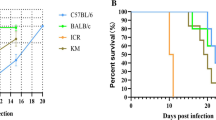Abstract
To mimic a human malaria infection in the endemic condition, two strains of mice (Balb/c and CBA) were infected and treated several times to generate so-called semi-immune status. As previously reported, neither mice (Balb/c and CBA) strain showed cerebral malaria, even in the susceptible C57BL/6 (B6). The significant difference between the mice strains in our previous study was the rate of destruction of uninfected red blood cells (uRBCs) at infection. After the established repeated cycles of infection and treatment and the final challenge with 104 Plasmodium berghei ANKA until minimum Hb, Balb/c and CBA mice were sacrificed. The spleen, liver, brain, kidney, lung, heart, and muscle were removed, stained with hematoxylin–eosin and analyzed with light microscopy. Previous observation suggested that Balb/c destroyed uRBC at much higher rate than the other strains although the parasitemia was very low. Pathological investigation carried out in this study revealed that this destruction was mainly contributed by the uRBCs as no parasite sequestration was observed in any of the organs. However, malaria pigment deposition was observed in spleen and liver of all the semi-immune mice strains. This histopathological study in the severe malaria anemia model, which is difficult to conduct in humans, will be helpful in taking into account different responses to malaria infection when designing therapeutic interventions and vaccine studies.







Similar content being viewed by others
References
Adun EH, Williams JS, Meroney FC, Hutt G (1965) Pathophysiology of Plasmodium berghei infection in mice. Exp Parasitol 17:277–286
Amante FH, Stanley AC, Randall LM, Zhou Y, Haque A, McSweeney K, Waters AP, Janse CJ, Good MF, Hill GR, Engwerda CR (2007) A role for natural regulatory T cells in the pathogenesis of experimental cerebral malaria. Am J Pathol 171:548–559
Baird JK (1998) Age-dependent characteristics of protection v. susceptibility to Plasmodium falciparum. Ann Trop Med Parasitol 92:367–390
De-Oliveira AC, Da-Matta AC, Paumgartten FJ (2006) Plasmodium berghei (ANKA): infection induces CYP2A5 and 2E1 while depressing other CYP isoforms in the mouse liver. Exp Parasitol 113:256–261
Donati D, Zhang LP, Chene A, Chen Q, Flick K, Nystrom M, Wahlgren M, Bejarano MT (2004) Identification of a polyclonal B-cell activator in Plasmodium falciparum. Infect Immun 72:5412–5418
Druilhe P, Perignon JL (1994) Mechanisms of defense against P. falciparum asexual blood stages in humans. Immunol Lett 41:115–120
Druilhe P, Perignon JL (1997) A hypothesis about the chronicity of malaria infection. Parasitol Today 13:353–357
Evans KJ, Hansen DS, van Rooijen N, Buckingham LA, Schofield L (2006) Severe malarial anemia of low parasite burden in rodent models results from accelerated clearance of uninfected erythrocytes. Blood 107:1192–1199
Franke-Fayard B, Janse CJ, Cunha-Rodrigues M, Ramesar J, Buscher P, Que I, Lowik C, Voshol PJ, den Boer MA, van Duinen SG, Febbraio M, Mota MM, Waters AP (2005) Murine malaria parasite sequestration: CD36 is the major receptor, but cerebral pathology is unlinked to sequestration. Proc Natl Acad Sci USA 102:11468–11473
Gramaglia I, Sobolewski P, Meays D, Contreras R, Nolan JP, Frangos JA, Intaglietta M, van der Heyde HC (2006) Low nitric oxide bioavailability contributes to the genesis of experimental cerebral malaria. Nat Med 12:1417–1422
Guha M, Kumar S, Choubey V, Maity P, Bandyopadhyay U (2006) Apoptosis in liver during malaria: role of oxidative stress and implication of mitochondrial pathway. FASEB J 20:1224–1226
Helegbe GK, Huy NT, Yanagi T, Shuaibu MN, Yamazaki A, Kikuchi M, Yasunami M, Hirayama K (2009) Rate of red blood cell destruction varies in different strains of mice infected with Plasmodium berghei-ANKA after chronic exposure. Malar J 8:91
Kochar DK, Agarwal P, Kochar SK, Jain R, Rawat N, Pokharna RK, Kachhawa S, Srivastava T (2003) Hepatocyte dysfunction and hepatic encephalopathy in Plasmodium falciparum malaria. QJM 96:505–512
Lamb TJ, Langhorne J (2008) The severity of malarial anaemia in Plasmodium chabaudi infections of BALB/c mice is determined independently of the number of circulating parasites. Malar J 7:68
Langhorne J, Quin SJ, Sanni LA (2002) Mouse models of blood-stage malaria infections: immune responses and cytokines involved in protection and pathology. Chem Immunol 80:204–228
Martins YC, Smith MJ, Pelajo-Machado M, Werneck GL, Lenzi HL, Daniel-Ribeiro CT, Carvalho LJ (2009) Characterization of cerebral malaria in the outbred Swiss Webster mouse infected by Plasmodium berghei ANKA. Int J Exp Pathol 90:119–130
Pamplona A, Clark IA, Mota MM (2007) Severe malaria increases the list of heme oxygenase-1-protected diseases. Future Microbiol 2:361–363
Penet MF, Laigle C, Fur YL, Confort-Gouny S, Heurteaux C, Cozzone PJ, Viola A (2006) In vivo characterization of brain morphometric and metabolic endophenotypes in three inbred strains of mice using magnetic resonance techniques. Behav Genet 36:732–744
Penet MF, Kober F, Confort-Gouny S, Le Fur Y, Dalmasso C, Coltel N, Liprandi A, Gulian JM, Grau GE, Cozzone PJ, Viola A (2007) Magnetic resonance spectroscopy reveals an impaired brain metabolic profile in mice resistant to cerebral malaria infected with Plasmodium berghei ANKA. J Biol Chem 282:14505–14514
Turrini F, Schwarzer E, Arese P (1993) The involvement of hemozoin toxicity in depression of cellular immunity. Parasitol Today 9:297–300
Acknowledgment
GKH is a recipient of Ph.D. scholarship from the Japanese Government Ministry of Education, Science, Sports, and Culture. This work was supported in part by a “Grant-in-Aid for Young Scientists” (17301870, 2008–2009 for NTH) from Ministry of Education, Culture, Sports, Science and Technology (MEXT) of Japan and was supported in part by a “Grant-in-Aid for Scientific Research” from Nagasaki University to NTH (2007–2009). This study was also supported in part by Global COE Program for KH (2008–2012).
Competing interest
There is no competing interest for any of the authors of the manuscript either due to commercial or other affiliations.
Author information
Authors and Affiliations
Corresponding authors
Rights and permissions
About this article
Cite this article
Helegbe, G.K., Yanagi, T., Senba, M. et al. Histopathological studies in two strains of semi-immune mice infected with Plasmodium berghei ANKA after chronic exposure. Parasitol Res 108, 807–814 (2011). https://doi.org/10.1007/s00436-010-2121-6
Received:
Accepted:
Published:
Issue Date:
DOI: https://doi.org/10.1007/s00436-010-2121-6




